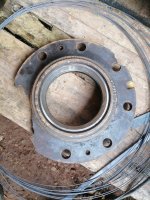The most common brazing rod is a brass alloy and it has a lot of zinc in it. It melts at about 1600° F. Silicon bronze rod melts about 300 degrees hotter. Silicon bronze is about 3% silicon and 97% copper. Just adding 3% silicon significantly increases the strength over pure copper. It is stronger than zinc containing brazing rod.
When it comes time to braze the part make sure the part is fixtured well so that it cannot move during the repair process. You can make your heat containing setup with fire brick, red brick, or ceramic wool. You can even use dry sand piled around your part. Messy but maybe that's all you can get. After the part is well fixtured and surrounded with the heat retaining material make sure you have your rod and some powdered flux ready. Start heating the part and when it is good and hot throughout start heating the area to be brazed with the oxy-acetylene torch. Shake some flux onto the work and when the area starts to get hot enough the powder will stick and then start to melt. Heat the end of your rod and dip it into the flux. The flux will stick. When you think the work is hot enough rub the brazing rod on the work. It should start to mark the part or even melt the rod. This is what you want. Melt the rod with the work, not the torch. The torch is for heating the work, the part to be brazed, and not for melting the brazing rod. Don't try melting the rod with the flame and then try to get the molten brazing rod to stick. It won't. Once the work starts to melt the rod work quickly to completely wet the surfaces to be brazed. Rub the brazing rod into the work. You will get the hang of it fast and it will be fun. You will need to keep dipping the brazing rod in the flux as the rod gets used up.
It is important, once you start using the flux, to bring the work up to brazing temp quickly and then to work quickly. This is because the flux does two things: it cleans oxides from the metal and it prevents more oxides from forming. It does this by absorbing oxygen. The flux can only absorb so much oxygen which is why you need to work fast. Using too little heat is bad because it takes too long for the work to get hot enough and the hot flux will absorb all the oxygen it can and quit working.
Once the flux quits working the only option is to stop brazing and clean the flux off and then start over. Adding more flux to used up flux is useless. Used up flux often turns very dark brown or black and is called burnt flux for obvious reasons. Anyway, burnt flux must be removed before adding new flux. Trying to fix burnt flux by adding more flux is pointless. It's like trying to get dry underwear after peeing your pants by putting on dry underwear over your wet underwear. It just won't work. I'm really stressing this because using too little heat and burning the flux are two of the most common mistakes when brazing. I have done it more than once.
Other folks here are giving you good advice and I hope my advice is as good and helpful. Also, there are lots of good YouTube videos about brazing and you should find and watch a few of them. Then your chance of success on this job will greatly improve and you can show us all some pictures of the great job you did.
Eric
